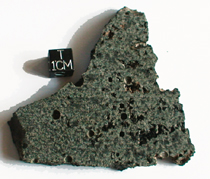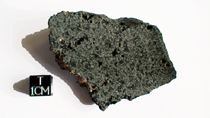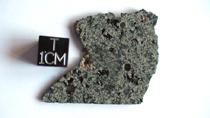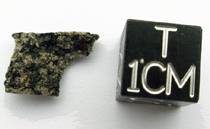Angrites
The achondrites of this group are named for their type specimen, Angra
dos Reis, a meteorite that fell in Rio de Janeiro, Brazil, in early 1869.
Angra dos Reis is a unique igneous rock that is largely composed of the
rare pyroxene fassaite, an aluminium-titanium diopside. During the last
two decades, a handful of similar fassaite-rich meteorites have been
recovered, leading to the establishment of the angrite group, presently
comprising six members.
The angrites are primarily composed of varying amounts of fassaitic
pyroxene, anorthitic plagioclase, minor olivine, kirschsteinite, along
with other accessory minerals and phases. They are basaltic rocks with
cumulate textures, often containing porous areas and abundant round
vesicles with diameters up to 2.5 cm. These vesicles have been interpreted
as remnants of gas-bubbles that formed prior to the crystallization of the
rock. However, current research suggests that the vesicles originally were
solid spheres that have been exsolved in subsequent stages of
rock-formation. Both theories are consistent with a magmatic origin of the
angrites, making them the most ancient igneous rocks known. They show
crystallization ages of ~ 4.55 billion years, which suggests their
formation occurred in the early days of the unfolding solar system. The
angrites are thought to have formed on one of the earliest differentiated
asteroids from the igneous processing of CAI-rich chondritic matter,
similar to carbonaceous chondrites of the CI or CM group.
By comparing the reflectance spectra of the angrites to that of several
main belt asteroids, two analogs were identified - 289 Nenetta, and 3819
Robinson. Further research will determine whether one of these asteroids
actually represents the angrite parent body. Only three angrites are
currently available to the private collector; these are Sahara 99555, a
single stone that was found in the Sahara desert in 1999, D'Orbigny,
an Argentinian find from 1979 that wasn't recognized as a meteorite until
1998 and NWA 1670 with a total weight of only 30gr....
|
D'Orbigny Angrite D’Orbigny,
Buenos Aires Province, Argentina
Found in 1998
TKW : 16.5 kg
|
|
contact us
|
 
|
|
|
|
D'orbigny 00
incredible slice with many bubbles, druses filled of
crystals and fusion crust.... no comments !!
70.43gr
Price
on request
|
|
D'orbigny 01
crusted end cut with many bubbles
71.80gr
SOLD
|
|
|
|
  |
|
|
|
|
|
|
 
|
|
|
|
D'orbigny 02
Thin slice with bubbles and druses
9.30gr
SOLD |
|
|
|
|
|
|
|
D'orbigny 03
Broken fragment
0.38gr
SOLD
|
|
|
|
  |
|
|
|
|
|
|
 
|
|
|
|
D'orbigny 04
Very nice slice !
0.344 gr
SOLD |
|
|
|
|
|
|
|
D'orbigny 05
Small endcut with a patch of crust !
0.318gr
SOLD
|
|
|
|
  |
|
|
|
|
|
|
|
D’ORBIGNY: A NEW WINDOW INTO ANGRITE GENESIS*.
G. Kurat1, M. E. Varela2, F. Brandstätter1, E. Wäsch3 and M.
A. Nazarov4, 1Naturhistorisches Museum, Postfach 417, A-1014 Vienna, Austria (gero.kurat@univie.ac.at);
² Dept. de Geologia, Universidad Nacional del Sur, 8000
Bahia Blanca, Argentina (evarela@criba.edu.ar); 3Museum für Naturkunde, Humboldt-Universität
Berlin, D-10115 Berlin, Germany (elke.waesch@rz.hu-berlin.de); 4Vernadsky
Institute of Geochemistry and Analytical Chemistry,
Kosygin Str. 19, Moscow, Russia (nazarov@geokhi.ru).
In memory of Marty Prinz who was supposed to provide us with his
expertise but was not permitted to do so.
Introduction: D’Orbigny,
Buenos Aires Province, Argentina, is the sixth and by far
the largest angrite known. Its bulk chemical and mineral
chemical compositions, rare gas abundances and oxygen and
rare gas isotope compositions fit the compositional ranges
known from angrites [1]. D’Orbigny, however, is peculiar
with respect to three features: the abundance of shelled
hollow spheres, the presence of abundant open druses and
the abundant presence of glasses [1, 2]. Thanks to the co-operation
of the owner of D’Orbigny we had the opportunity to
investigate in detail and in an unusual way this unusual
rock. Here is a brief preliminary report.
Shape of the stone: D’Orbigny,
as it was found, had a somewhat unusual shape (Fig.1). As
a typical oriented-flight stone it had a front shield (~
35 cm long) which gently sloped from the stagnation center
and which was covered by regmaglypts and a dark brown
fusion crust. The back side had a much smaller diameter (~
20 cm) and consisted of a concave, round, pan-like
indentation with a marked large (2 cm) and several smaller,
round open vugs. It was also covered by fusion crust, much
less than the front side, and had also less developed
regmaglypts. The front and back shields were curved in a
semi-parallel way and were intergrown on one side with the
opposite side opening like a clam. The space between the
plates was filled by a highly porous lithology, very rich
in open druses and hollow spheres, partly filled by
caliche.
Textures and structure: In
an attempt to avoid too much contamination we decided to
part the meteorite by breaking. Hammer with or without
chisel turned out not to be suitable because the porous
portion of the rock was physically week and tended to
crumble. Consequently, the parting was done with a heavy
hydraulic press, the smaller parting with a laboratory
hydraulic press. The front and back shield lithology is a
dense, medium to coarse–grained, sub-ophitic basaltic
rock (see Fig. in [1]. It consists mainly of anorthite,
augite and olivine. Anorthite forms hollow and hopper –
like plates which enclose olivine and augite and which are
intergrown with olivine and partly enclosed by large
augite crystals. Olivine and augite are compositionally
zoned from Fo20 to kirschsteinite and from En27Fs22Wo51 to
En1Fs47Wo53, respectively [1]. Thisshield lithology contains also occasional
hollow spheres ("vugs", see below), small,
almost closed druses with augite and anorthite crystals
and some large (cm) olivine xenocrysts(?). The hollow
spheres are unevenly distributed throughout D’Orbigny,
present in all parts, but most common in the porous inner
portion. They are between a few mm and 2.5 cm in diameter.
The shell is a dense granular intergrowth of fine-grained
anorthite and olivine with occasionally some augite at the
outside (Fig. 2). The grains tend to be oriented perpendicular
to the surface. The inner side of the shell is fairly
smooth but has a roughness suggestive of replicating a former
solid filling with granular texture (shell fills former indentations
at grain boundaries, see Fig.1 in [2]). The surface is
commonly lined with a thin cover of sulphides. Druses are
omnipresent in the porous portion of D’Orbigny. They are
irregular, open spaces up to 3+ cm in elongation into
which perfectly crystallized augites of prismatic habit and
anorthite plates protrude. Druses border to walls consisting of
a coarse-grained, porous, ophitic basaltic rock rich in
anorthite and augite and poor in olivine. Druses commonly also
border to shells of hollow spheres with the protruding crystals
originating at the shell’s surface (Fig.3). The porous
part of D’Orbigny contains many large olivine crystals
and also some polycrystalline olivinite (Fig.5). The
shapes of these olivinites are very complex and rather suggestive
of irregular pore space than of fragmental shapes. Also
common in the porous part are glasses filling in part druse
space, interstitial space between olivine, augite, or anorthite
grains and filling former hollow spheres [2].
Discussion and conclusion: The
shape of D’Orbigny, its structure with highly porous
lithologies alternating with denser ones and its
mineralogical heterogeneity strongly suggest that the rock
was not formed by a simple crystallisation of a basaltic
melt. The mushroom – like aspect of D’Orbigny and the
alternating texturally different layers are suggestive of
a directional growth structure rather than of an igneous
or metamorphic rock fragment. The abundantly present
druses give clear evidence for a pneumatolytic process and
the gradations from druses to less porous, coarsegrained, ophitic
basaltic rock suggest growth of the whole entity under
similar conditions. The hollow spheres appear to be the
oldest building unit. Solid spheres of unknown composition
(we may speculate on CaS or nitrides) were covered by
anorthite + olivine at the earliest stage of rock formation.
The solid core of the spheres was subsequently lost. It is
possible that this phase became unstable, presumably during
the late, highly oxidizing event that created
Lunar and Planetary Science XXXII (2001) 1737.pdf
D'ORBIGNY: GENESIS OF ANGRITES: G. KURAT et al. the
Fe-augite and kirschsteinite rims. The decomposing phase
may also have supplied the Ca necessary for the formation of
kirschsteinite. The latest event appears to have been the
precipitation of glasses into some of the open pore spaces.
The origin of the glass and the fact that some spaces were
filled, but others not, remains a mystery, as does the origin
of olivinite, which likely was formed at an early developing stage,
before the very strong Fe-Ca metasomatism occurred. Plenty
of work remains to be done.
References: [1] Kurat G
et al., this volume; [2] Varela M.E et al., this volume.
Acknowledgements: We
thank the owner of the meteorite for his co-operation. The
study was supported by FWF in Austria ( P-13975-GEO, G.K.,
P.I.), the Austrian Academy of Sciences and CONICET,
Argentina.
Lunar and Planetary Science XXXII (2001) 1737.pdf
|